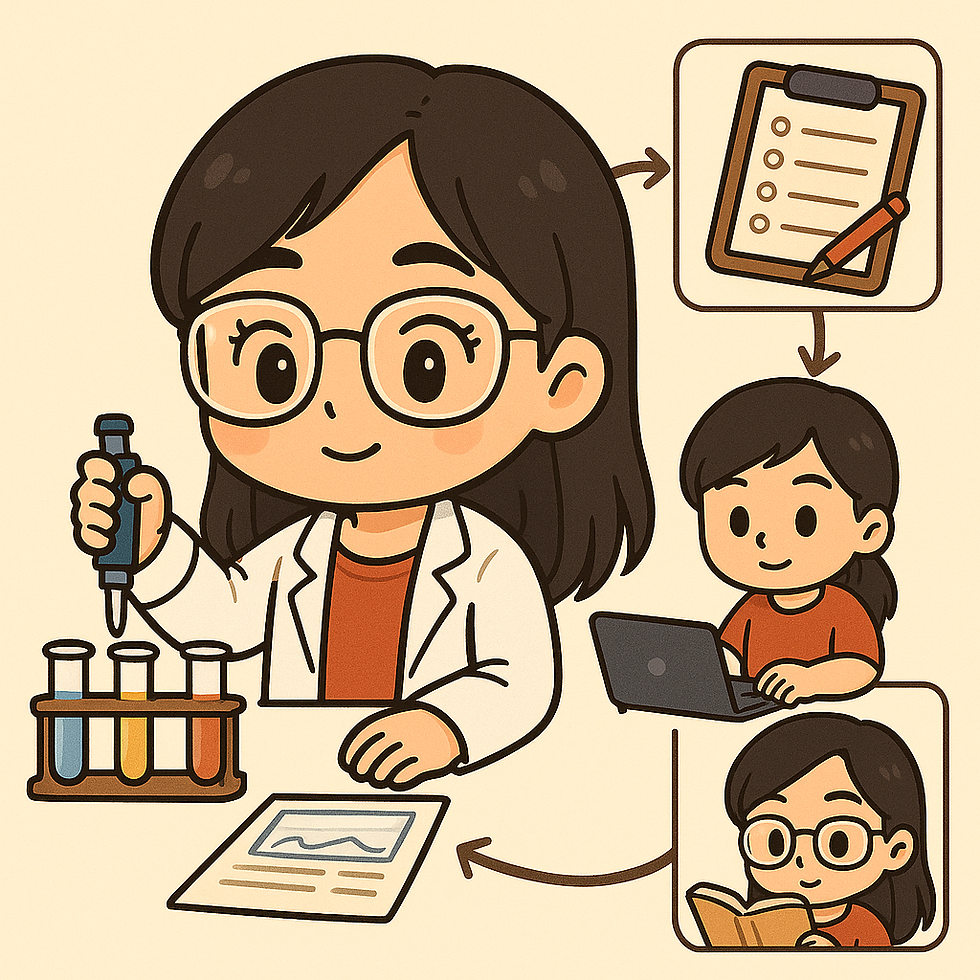A High Schooler’s Guide to Doing Research (Part 2): Choosing Your Topic & Narrowing Your Focus
- jophy2467
- Apr 27
- 5 min read
Updated: Aug 26
In Part 1 of this series, we talked about what research really means — not just Googling sources or writing a school report, but the process of asking questions, seeking answers, and creating knowledge that hasn’t existed before. That’s a big mindset shift, and once you start thinking this way, the natural next question is: Where do I even start?
The first step is choosing a research topic. And while that sounds simple, this is actually one of the hardest parts of the entire process. Many high schoolers get stuck here because they either pick something too broad (e.g., “the effects of climate change”), too vague (e.g., “social media and teens”), or too ambitious (e.g., “finding a cure for cancer”). Others struggle because they’re picking a topic they think sounds impressive to colleges, instead of something they actually care about.
This article is all about helping you move past that stuck feeling. By the end, you’ll have a clear sense of how to turn your general interests into a researchable, specific, and exciting project you can actually carry through.


Why Choosing a Topic Matters So Much
Picking the right topic is like setting the foundation for a house. If your foundation is shaky - too broad, too shallow, or disconnected from your interests - everything else you try to build will feel unstable. You’ll lose motivation halfway through, or realize your project isn’t doable with your resources.
But if your topic is focused and meaningful, the entire process feels smoother. You’ll know what direction to take, and each step (e.g., finding sources, designing methods, analyzing results) will naturally fall into place. A good topic keeps you motivated when you hit roadblocks, and it ensures your project stays realistic while still being impactful.
So, choosing your topic isn’t just the “first step” - it’s one of the most important steps you’ll take.
From Broad Interests to Potential Topics
Start with brainstorming. Write down every area you’re curious about, without worrying if it’s “good enough.” This is your raw material. Some examples might include:
Medicine & health
Artificial Intelligence & machine learning
Education & learning styles
Mental health in teenagers
Environmental sustainability
Social media & identity
Now ask yourself: What do I actually care about? Maybe your grandma has diabetes, so you’re interested in health. Maybe you’ve been teaching yourself Python, so AI feels exciting. Maybe you’re frustrated with how much time your classmates spend on TikTok, so you’re curious about its effects.
When you make that personal connection, your research becomes more than just an assignment - it becomes meaningful.
The Art of Narrowing Down
This is the step most students skip. You can’t research “climate change” or “AI.” They’re way too big. The trick is to narrow down until your question is specific enough to study. Here are some ways to do that:
1. Ask “Which part?”
Break your topic into smaller pieces. For example:
Instead of climate change, try: “How do rising temperatures affect local bird migration patterns in New Jersey?”
Instead of AI, try: “How accurate are transfer learning models at detecting early signs of melanoma compared to simple neural networks?”
2. Add a specific lens
Look at your topic from one angle. For example:
Instead of social media, try: “How does TikTok usage influence self-esteem among high school juniors?”
Instead of education, try: “Do group study sessions improve retention in AP Physics classes?”
3. Think small, then expand
Start with what you can access. For example:
Instead of pollution, try: “What effect does winter road salt have on soil pH in my town?”
Instead of mental health, try: “How does journaling affect stress levels in high school students before exams?”
4. Consider feasibility
Ask yourself: Do I have the tools, data, and time? For example, you may want to research brain imaging, but unless you have access to an MRI machine, it’s not realistic. Narrow your scope to what’s possible.
The Importance of a Research Question
Once you’ve narrowed your topic, the next step is to frame it as a clear research question. A good research question is:
Specific: It zooms in on one variable or relationship
Researchable: You can actually collect data or evidence
Open-ended: It’s not a simple yes/no question
Relevant: It matters to you and potentially to others
Examples:
Instead of: “What are the effects of caffeine?”→ Ask: “How does caffeine consumption affect sleep duration in high school juniors?”
Instead of: “Does social media affect teens?”→ Ask: “How does daily Instagram use influence self-perception of body image among high school girls?”
See the difference? The second versions are sharper, measurable, and realistic!!!
Common Mistakes to Avoid
Here are some mistakes I've observed others make during my research process:
Choosing a “college essay” topic instead of a real interest: Don’t pick something just because you think admissions officers want to see it. Passion shows through your work - and so does faking it.
Being too broad: If your topic could fill a library, it’s too big. Narrow it.
Being too ambitious: You can’t solve world hunger in three months. But you can study how food banks in your county receive donations over the year.
Skipping feedback: Sometimes what feels “narrow enough” is still broad. Run your topic by a teacher, mentor, or even a friend to see if it’s clear.
Real-World Student Examples
Here are some ways other high schoolers (like you) have narrowed their focus:
Broad Idea: Diabetes → Focused Research: “How does meal timing affect blood sugar levels in diabetic teens?”
Broad Idea: Identity → Focused Research: “How does using multiple languages at home shape cultural identity in first-generation high school students?”
Broad Idea: Pollution → Focused Research: “What is the impact of road salt on aquatic plant growth in local ponds?”
Broad Idea: AI → Focused Research: “How effective is transfer learning for image classification when applied to limited medical datasets?”
From this, you can notice how these projects went from overwhelming to doable.
Practical Tips for High Schoolers
Start local: Your backyard, school, or community is full of opportunities. Research doesn’t need a huge lab to be meaningful.
Look for data you can access: Public datasets, school surveys, or simple experiments can take you far.
Embrace curiosity, not perfection: You won’t land on the perfect topic right away. It’s normal to refine and re-refine.
Keep a “question journal”: Write down things you notice daily that make you wonder. Small curiosities often grow into strong research questions.
Final Verdict
Choosing and narrowing your topic is less about finding a “perfect” idea and more about learning how to shape curiosity into a manageable project. Don’t be afraid to start broad and refine multiple times. The best projects don’t always sound groundbreaking at first glance - but they are when you pursue them with depth and persistence.
Remember: your topic doesn’t need to change the world. It just needs to be meaningful, specific, and doable with the resources you have. Once you nail that down, the rest of the research process will feel more natural.
In Part 3, we’ll move from the “what” to the “how.” You’ll learn how to take your narrowed question into the real world by finding background information for your research.

About the Author: I'm Jophy Lin, a high school junior and researcher. I blog about a variety of topics, such as STEM research, competitions, shows, and my experiences in the scientific community. If you’re interested in research tips, competition insights, drama reviews, personal reflections on STEM opportunities, and other related topics, subscribe to my newsletter to stay updated!



Comments